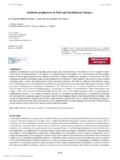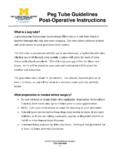Transcription of American Association of Oral and Maxillofacial Surgeons
1 American Association of oral and Maxillofacial Surgeons Position Paper on Bisphosphonate-Related Osteonecrosis of the Jaws Approved by the Board of Trustees September 25, 2006. Introduction Bisphosphonate-related osteonecrosis of the jaw (BRON) adversely affects the quality of life and produces significant morbidity in afflicted patients. oral and Maxillofacial Surgeons have been responsible for counseling, managing, and treating a majority of these patients. The strategies set forth in this position paper were developed by a Task Force appointed by the American Association of oral and Maxillofacial Surgeons (AAOMS). The Task Force was composed of clinicians with extensive experience in caring for these patients, clinical epidemiologists, and basic science researchers offering a broad range of experience and background. (See Acknowledgements.) The strategies are based on an analysis of the existing literature and the clinical observations of the expert Task Force members.
2 AAOMS considers it vitally important that this information be disseminated to other dental and medical specialties. It is understood that the strategies and treatment algorithms outlined in this paper are starting points based on our current understanding of BRON. As the knowledge base and experience in addressing BRON. evolves, future modifications and refinements of the current strategies will necessarily be required. Purpose The purpose of this position paper is to provide: 1. perspectives on the risk of developing BRON and the risks and benefits of bisphosphonates in order to facilitate medical decision-making of both the treating physician and the patient;. 2. guidance to clinicians regarding the differential diagnosis of BRON in patients with a history of treatment with intravenous (IV) or oral bisphosphonates; and 3. guidance to clinicians on possible BRON prevention measures and management of patients with BRON based on the presenting stage of the disease.
3 Background Benefits of bisphosphonate therapy Intravenous bisphosphonates are primarily used and effective in the treatment and management of cancer-related conditions. These include hypercalcemia of malignancy, skeletal-related events associated with bone metastases in the context of solid tumors such as breast cancer, prostate cancer, and lung cancer, and in the management of lytic lesions in the setting of multiple myeloma. 1-12 The IV bisphosphonates are effective in preventing and reducing hypercalcemia, stabilizing bony pathology, and preventing fractures in the context of skeletal involvement. While they have not been shown to improve cancer-specific survival, they have had a significant impact on the quality of life for patients with advanced cancer that involves the skeletal system. Before 2001 pamidronate (Aredia ) was the only drug approved in the United States for treatment of metastatic bone disease.
4 In 2002 zoledronic acid (Zometa ) was approved for this indication by the US Food and Drug Administration (FDA). 12. oral bisphosphonates are approved to treat osteoporosis and are frequently used to treat osteopenia as well. 13 They are also used for a variety of less common conditions such as Paget's disease of bone, and osteogenesis imperfecta of childhood. 14-15 By far the most prevalent and 1. common indication, however, is osteoporosis. 16-17 Osteoporosis may arise in the context of other diseases such as inflammatory bowel disease or primary biliary cirrhosis, as the result of medications, most commonly steroids, or as a consequence of postmenopausal aging. 18-20. Whatever the underlying etiology of the osteoporosis, bisphosphonates may play a role, perhaps in conjunction with calcium and vitamin D, in its management. Risks of bisphosphonate therapy In 2003-04, oral and Maxillofacial Surgeons were the first clinicians to recognize and report cases of non-healing exposed bone in the Maxillofacial region in patients treated with IV.
5 Bisphosphonates. 21-22 Since these initial reports, several case series and reviews have been published. 23-30 In September 2004, Novartis, the manufacturer of the IV bisphosphonates pamidronate (Aredia ) and zoledronic acid (Zometa ), notified healthcare professionals of additions to the labelling of these products, which provided cautionary language related to the development of osteonecrosis of the jaws. 31 This was followed in 2005 by a broader drug class warning of this complication for all bisphosphonates including the oral preparations. 32-33 See Appendix 1 for list of bisphosphonate medications that are currently available in the United States. BRON Case Definition To distinguish BRON from other delayed healing conditions, the following working definition of BRON has been adopted by the AAOMS: Patients may be considered to have BRON if all of the following three characteristics are present: 1.
6 Current or previous treatment with a bisphosphonate;. 2. Exposed bone in the Maxillofacial region that has persisted for more than eight weeks; and 3. No history of radiation therapy to the jaws. It is important to understand that patients at risk for BRON or with established BRON can also present with other common clinical conditions not to be confused as BRON. Commonly misdiagnosed conditions may include, but are not limited to, alveolar osteitis, sinusitis, gingivitis/periodontitis, caries, periapical pathology, and TMJ disorders. Estimated Incidence and Factors Associated with Development of BRON. IV bisphosphonates and incidence of BRON. The clinical efficacy of IV bisphosphonates for the treatment of hypercalcemia and bone metastases is well established. 1-4 Currently available published incidence data for BRON are limited to retrospective studies with limited sample sizes. Based on these studies, estimates of the cumulative incidence of BRON range from 34-42 With increased recognition, duration of exposure, and follow-up, it is likely that the incidence will rise.
7 oral bisphosphonates and incidence of BRON. The clinical efficacy of oral bisphosphonates for the treatment of osteopenia/osteoporosis is well established and is reflected in the fact that over 190 million oral bisphosphonate prescriptions have been dispensed worldwide. 43 The specialty's experiences have identified several BRON. cases related to oral bisphosphonates. 22, 24 Patients under treatment with oral bisphosphonate 2. therapy are at a considerably lower risk for BRON than patients treated with IV bisphosphonates. Based on data from the manufacturer of alendronate (Merck), the incidence of BRON was calculated to be ,000 person years of exposure. 44 This was derived from the number of reported (not confirmed) cases that were deemed to likely represent BRON divided by the number of alendronate pills prescribed since approval of the drug, and converted to number of patient years. While this is the best available data to date, there may be serious under-reporting and, as noted above, none confirmed.
8 Correspondence with Alastair Goss, DDSc (September, 2006), reported that the estimated incidence of BRON for patients treated weekly with alendronate is , based on prescription data in Australia. Following extractions, this rate increased to Based on the above cited data, the risk of BRON for patients receiving IV bisphosphonates appears to be significantly greater than the risk for patients receiving oral bisphosphonates. Regardless, given the large number of patients receiving oral bisphosphonates for the treatment of osteoporosis/osteopenia it is likely that most practitioners may encounter some patients with BRON. It is important to accurately determine the incidence of BRON in this population and to assess the risk associated with long-term use, , greater than 3 years, of oral bisphosphonates. The effect of certain comorbidities, , chronic corticosteroid use, also requires further study. Risk factors Risk factors for the development of BRON can be grouped as drug-related, local risk factors, and demographic/systemic factors.
9 I. Drug-related risk factors include: A. Potency of the particular bisphosphonate: zoledronate (Zometa ) is more potent than pamidronate (Aredia ) and pamidronate (Aredia ) is more potent than the oral bisphosphonates; the IV route of administration results in a greater drug exposure than the oral route. 34-35, 42, 45. B. Duration of therapy: longer duration appears to be associated with increased risk. 35, 42. II. Local risk factors include: A. Dentoalveolar surgery, including, but not limited to 34, 42, 45. 1. Extractions 2. Dental implant placement 3. Periapical surgery 4. Periodontal surgery involving osseous injury Patients receiving IV bisphosphonates and undergoing dentoalveolar surgery are at least 7-times more likely to develop BRON than patients who are not having dentoalveolar surgery. 42, 45. B. Local anatomy 1. Mandible a. Lingual tori b. Mylohyoid ridge 3. 2. Maxilla a. Palatal tori It has been observed that lesions are found more commonly in the mandible than the maxilla (2:1 ratio) and more commonly in areas with thin mucosa overlying bony prominences such as tori, bony exostoses, and the mylohyoid ridge.
10 22, 24, 46. C. Concomitant oral disease Patients with a history of inflammatory dental disease, , periodontal and dental abscesses, are at a seven-fold increased risk for developing BRON. 42. III. Demographic and systemic factors A. Age: With each passing decade, there is a 9% increased risk for BRON in multiple myeloma patients treated with IV bisphosphonates. 45. B. Race: Caucasian 45. C. Cancer diagnosis: Risk is greater for patients with multiple myeloma than for patients with breast cancer; and those with breast cancer have a greater risk than those with other cancers. 42. D. Osteopenia/osteoporosis diagnosis concurrent with cancer diagnosis 42. The following factors are thought to be risk factors for BRON: 1. Corticosteroid therapy 2. Diabetes 3. Smoking 4. Alcohol use 5. Poor oral hygiene 6. Chemotherapeutic drugs Further studies are required to accurately determine if these factors are associated with BRON.








